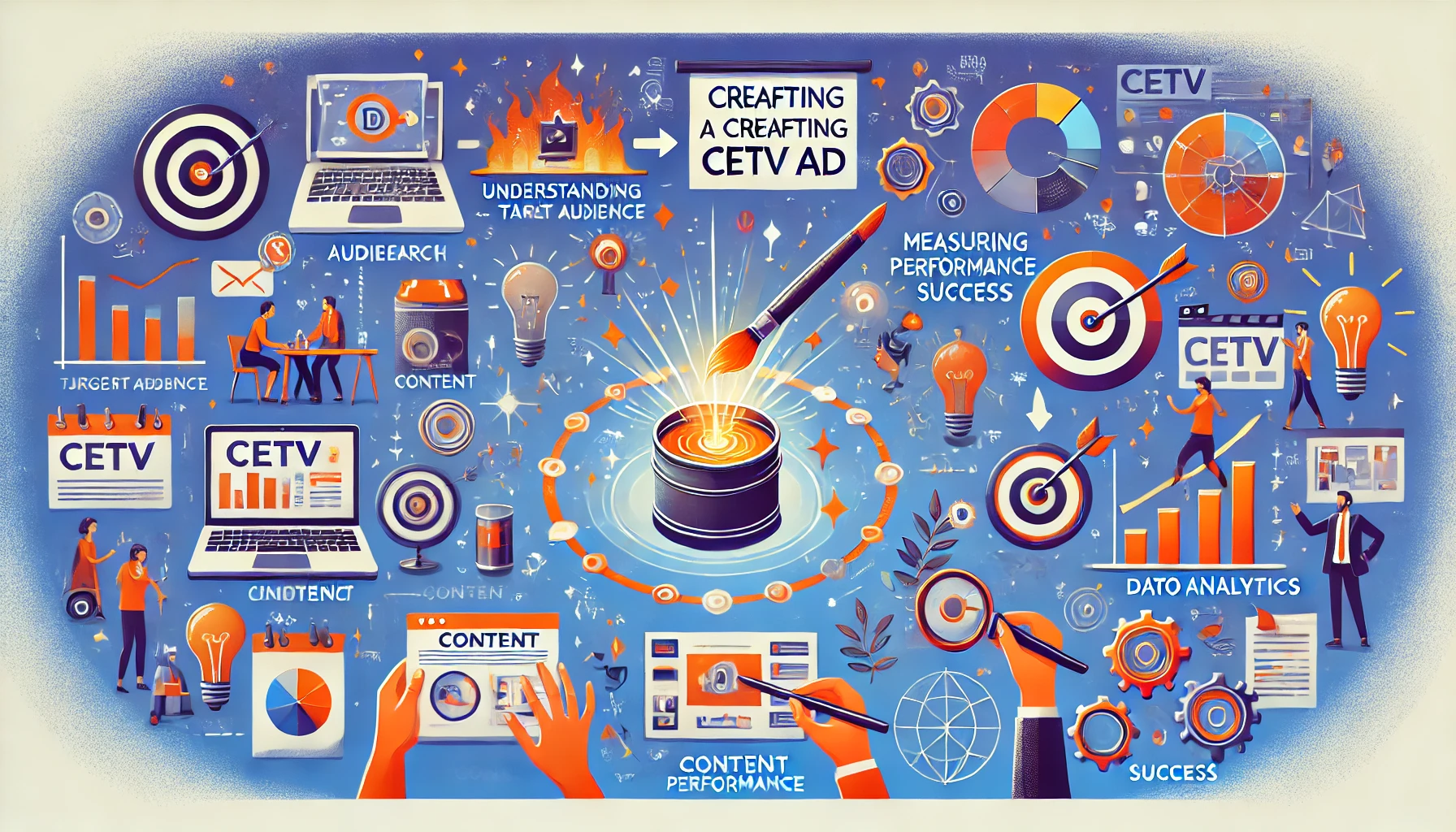In today’s fast-paced advertising landscape, crafting compelling CETV ads is more critical than ever for businesses aiming to capture audience attention and drive action. Whether you’re a small business owner in Phoenix or a large retailer in Miami, understanding the intricacies of CETV advertising can significantly impact your brand’s visibility and engagement.
CETV (Commercial Environment TV) offers a unique platform by placing your ads in high-traffic commercial environments where they can’t be skipped or ignored. This non-skippable nature ensures that your message reaches the intended audience every time, making it a powerful tool for marketers.
Why is mastering the art of crafting CETV ads so crucial? For one, it allows you to connect with your audience in a context that is conducive to decision-making. According to a study by Ipsos, TV advertising can lead to a 98% increase in branded search queries, driving more organic traffic to your website. Additionally, a report from Google highlights that TV ads can boost organic search traffic by up to 25%.
In this blog post, we will delve into the essential components of creating impactful CETV ads. You’ll learn how to utilize storytelling, optimize visuals and audio, and measure your ad’s performance to ensure maximum effectiveness. We’ll also explore real-world examples and case studies to provide actionable insights.
Ready to elevate your advertising game? Let’s dive into the world of crafting compelling CETV ads and discover how you can leverage this powerful medium to boost your brand’s presence and drive meaningful engagement.
Understanding Your Audience for Effective CETV Ads
To create effective CETV ads, it’s essential to understand your target audience. This involves analyzing demographic and psychographic factors, such as age, gender, interests, and media consumption habits. By tailoring your ad content to the preferences and expectations of your viewers, you can increase engagement and conversion rates.
Understanding your audience is the cornerstone of crafting compelling CETV ads. By delving into both demographic and psychographic data, you can tailor your content to resonate more deeply with your viewers. This approach not only increases engagement but also drives higher conversion rates.
Demographic Analysis: Who Are Your Viewers?
Demographic analysis involves examining factors such as age, gender, income level, education, and occupation. These elements provide a broad overview of who your audience is and help in creating ads that speak directly to them.
- Age: Different age groups respond to different types of content. For instance, younger audiences may prefer dynamic and visually engaging ads, while older demographics might appreciate more informative and straightforward content.
- Gender: Understanding gender preferences can help tailor your messaging and visuals. For example, an ad targeting women might focus on emotional storytelling, while one targeting men might emphasize practicality and features.
- Income Level: Income influences purchasing power and can guide the positioning of your product or service. High-income audiences might respond better to luxury and premium offerings, whereas budget-friendly options might appeal to lower-income groups.
- Education and Occupation: These factors can influence the complexity of the language and the type of information included in your ads. Professionals might appreciate detailed and technical content, while a general audience might prefer simpler, more accessible messaging.
Using demographic data, you can create a profile of your ideal viewer and tailor your CETV ads to meet their specific needs and preferences.
Psychographic Analysis: What Motivates Your Audience?
Psychographic analysis goes beyond demographics to explore the attitudes, interests, values, and lifestyles of your audience. This deeper understanding allows you to create more personalized and impactful ads.
- Interests: Knowing what your audience is passionate about can help you create content that resonates with them. For example, if your target audience is interested in fitness, incorporating health-related themes and visuals can make your ad more appealing.
- Values: Aligning your ad content with the core values of your audience can create a stronger emotional connection. If your audience values sustainability, highlighting eco-friendly aspects of your product can enhance engagement.
- Lifestyle: Understanding the daily routines and habits of your audience can help in timing and placing your ads effectively. For instance, ads targeting busy professionals might be more effective during commuting hours.
- Media Consumption Habits: Knowing where and how your audience consumes media can guide your ad placement strategy. If your audience prefers watching content on mobile devices, optimizing your ads for mobile viewing is crucial.
Psychographic insights enable you to create ads that not only capture attention but also resonate on a personal level, driving higher engagement and conversion rates.
Utilizing Data to Tailor Ad Content
Combining demographic and psychographic data provides a comprehensive understanding of your audience. This information can be used to tailor your ad content in several ways:
- Personalized Messaging: Craft messages that speak directly to the needs and desires of your audience. Personalization can significantly increase the relevance and impact of your ads.
- Visual and Audio Elements: Use visuals and audio that align with the preferences of your target audience. For instance, vibrant and dynamic visuals might appeal to younger viewers, while more subdued and professional visuals might resonate with an older audience.
- Storytelling: Develop narratives that reflect the experiences and aspirations of your audience. Storytelling can create an emotional connection and make your ads more memorable.
- Call-to-Action (CTA): Tailor your CTAs to the behavior and preferences of your audience. A clear and compelling CTA can drive viewers to take the desired action, whether it’s visiting your website, making a purchase, or signing up for a newsletter.
By leveraging data to tailor your ad content, you can create CETV ads that are not only compelling but also highly effective in driving engagement and conversions.
Crafting a Compelling Narrative for CETV Ads
Creating a compelling narrative is essential for capturing audience attention and establishing an emotional connection with your brand. Storytelling techniques, such as vivid imagery and relatable characters, can make your CETV ads more memorable and effective. In this section, we will explore the importance of storytelling in advertising and provide tips for crafting engaging stories that resonate with viewers.
Storytelling in advertising is not just about selling a product; it’s about creating an experience that viewers can connect with on a personal level. By weaving a narrative that reflects the values and aspirations of your audience, you can create a powerful and lasting impression.
The Power of Storytelling in Advertising
Storytelling has been a fundamental aspect of human communication for centuries. In advertising, it serves as a bridge between the brand and the consumer, allowing for a deeper connection. According to a study by Nielsen, ads that tell a story are more likely to be remembered and shared, leading to higher engagement and conversion rates.
One of the key elements of effective storytelling is the use of relatable characters. When viewers see themselves in the characters of your ad, they are more likely to connect with the message. For example, a home cleaning company might feature a busy parent who finds relief in using their services, making the ad relatable to other parents facing similar challenges.
Elements of a Compelling Narrative
To craft a compelling narrative for your CETV ads, consider incorporating the following elements:
- Relatable Characters: Characters that reflect the demographics and psychographics of your target audience can create a strong emotional connection.
- Conflict and Resolution: A story that presents a problem and offers a solution keeps viewers engaged and highlights the value of your product or service.
- Emotional Appeal: Emotions drive decision-making. Ads that evoke happiness, nostalgia, or even urgency can be more persuasive.
- Clear Message: Ensure that the core message of your ad is clear and aligns with your brand values.
- Visual and Audio Elements: Use high-quality visuals and audio to enhance the storytelling experience. Vivid imagery and compelling soundtracks can make your ad more memorable.
Examples of Successful Storytelling in CETV Ads
Let’s look at some examples of successful storytelling in CETV ads:
Example 1: The Home Service Vertical
A pest control company created an ad featuring a family dealing with a pest infestation. The narrative follows their journey from frustration to relief as the pest control service resolves their problem. The ad uses relatable characters and a clear conflict-resolution structure to engage viewers.
Example 2: The Medical Vertical
A med spa produced an ad showcasing a client’s transformation journey. The story highlights the client’s initial insecurities and the confidence they gain after undergoing treatments at the spa. This emotional appeal resonates with viewers who may have similar insecurities.
Example 3: The Small Business Vertical
An auto detailing service created an ad featuring a car enthusiast who takes pride in maintaining their vehicle. The narrative emphasizes the meticulous care and attention to detail provided by the service, appealing to viewers who value quality and craftsmanship.
These examples demonstrate how storytelling can be tailored to different industries and target audiences, making CETV ads more engaging and effective.
Tips for Crafting Engaging Stories
Here are some tips for crafting engaging stories for your CETV ads:
- Know Your Audience: Understand the demographics, interests, and values of your target audience to create stories that resonate with them.
- Keep It Simple: A clear and concise story is more likely to be remembered. Avoid overcomplicating the narrative with too many details.
- Use Vivid Imagery: Visual elements can enhance the storytelling experience. Use high-quality visuals that support the narrative and capture attention.
- Incorporate a Strong Call-to-Action: Ensure your story leads to a clear and compelling call-to-action, encouraging viewers to take the desired next step.
- Test and Refine: Use data and feedback to refine your storytelling approach. Test different narratives to see which ones resonate best with your audience.
By following these tips and leveraging the power of storytelling, you can create CETV ads that not only capture attention but also drive meaningful engagement and conversions.
Optimizing Visuals and Audio for CETV Ads
High-quality visuals and audio are essential for creating impactful CETV ads. Investing in professional production ensures that your content meets the high standards expected by viewers and stands out in a commercial environment. In this section, we will explore the importance of high-quality production values and provide tips for optimizing visuals and audio in CETV ads.
In the competitive landscape of CETV advertising, the quality of your visuals and audio can make or break your ad’s effectiveness. Viewers are more likely to engage with content that is visually appealing and audibly clear. Let’s delve into how you can achieve this.
Importance of High-Quality Production Values
High-quality production values are crucial for several reasons. Firstly, they enhance the credibility of your brand. Ads with poor visuals or audio can appear unprofessional, leading viewers to question the reliability of your business. According to a study by Nielsen, ads with high production quality are more likely to be remembered and trusted by viewers.
Secondly, high-quality visuals and audio can significantly increase viewer engagement. In a commercial environment where distractions are plentiful, striking visuals and clear audio can capture and retain viewer attention. This is particularly important for CETV ads, where the goal is to move audiences into action.
Lastly, investing in professional production can provide a competitive edge. In markets like Phoenix, Scottsdale, Dallas, and Miami, where businesses are vying for consumer attention, high-quality ads can set your brand apart from the competition.
Tips for Optimizing Visuals in CETV Ads
To optimize visuals in your CETV ads, consider the following tips:
- Use High-Definition (HD) Footage: Ensure your ad is shot in HD to provide clear and crisp visuals. This can enhance the overall viewing experience and make your ad more appealing.
- Incorporate Vibrant Colors: Use vibrant and contrasting colors to make your ad stand out. This can help capture viewer attention in busy commercial environments.
- Focus on Composition: Pay attention to the composition of your shots. Use the rule of thirds to create balanced and visually pleasing images.
- Include Dynamic Visuals: Incorporate dynamic visuals such as animations or motion graphics to add interest and keep viewers engaged.
- Consistency with Brand Identity: Ensure that the visuals align with your brand identity. Consistent use of colors, fonts, and logos can reinforce brand recognition.
Tips for Optimizing Audio in CETV Ads
Audio quality is just as important as visual quality in CETV ads. Here are some tips for optimizing audio:
- Use Professional Voiceovers: Invest in professional voiceover artists to deliver your message clearly and effectively. A well-spoken voice can enhance the credibility of your ad.
- Ensure Clear Sound Quality: Use high-quality microphones and recording equipment to capture clear and crisp audio. Avoid background noise and ensure that the audio levels are balanced.
- Incorporate Music and Sound Effects: Use music and sound effects to enhance the emotional appeal of your ad. Ensure that the music complements the visuals and does not overpower the voiceover.
- Sync Audio with Visuals: Ensure that the audio is perfectly synced with the visuals. This can enhance the overall viewing experience and make your ad more engaging.
- Test Audio Levels: Test the audio levels in different environments to ensure that it is audible and clear in various commercial settings.
Case Studies: Impact of High-Quality Production Values
Let’s look at some examples of how high-quality production values have impacted CETV ads:
Example 1: The Home Service Vertical
A pest control company invested in professional production for their CETV ad. The ad featured high-definition visuals of a clean and pest-free home, accompanied by a clear and reassuring voiceover. The result was a 30% increase in customer inquiries within the first month of airing.
Example 2: The Medical Vertical
A med spa created an ad showcasing their state-of-the-art facilities and happy clients. The ad used vibrant colors and soothing background music to create a relaxing atmosphere. This high-quality production led to a 25% increase in appointment bookings.
Example 3: The Small Business Vertical
An auto detailing service produced an ad with dynamic visuals of their detailing process and a professional voiceover explaining the benefits. The ad’s high production values helped the business achieve a 20% increase in service requests.
These examples demonstrate the significant impact that high-quality production values can have on the effectiveness of CETV ads. By investing in professional visuals and audio, businesses can create compelling ads that capture attention and drive action.
Measuring Success and Refining Your CETV Ad Strategies
Measuring the success of your CETV ads is crucial for continuous improvement. Tracking key performance indicators (KPIs) such as viewer engagement, click-through rates, and conversion metrics can provide valuable insights into the effectiveness of your ads.
To ensure your CETV advertising campaigns are as effective as possible, it is important to regularly measure and refine your strategies based on data-driven insights. This approach allows you to understand what works, what doesn’t, and how to optimize your ads for better performance.
The Importance of Measuring Ad Performance
Understanding the impact of your CETV ads is essential for making informed decisions about future campaigns. By measuring performance, you can identify areas of improvement and allocate resources more effectively. Here are a few reasons why measuring ad performance is crucial:
- Identify Strengths and Weaknesses: Performance metrics help you pinpoint which aspects of your ads are resonating with viewers and which need adjustment.
- Optimize Budget Allocation: By understanding which ads deliver the best results, you can allocate your budget more efficiently.
- Enhance Audience Targeting: Data insights allow you to refine your audience targeting strategies, ensuring your ads reach the most relevant viewers.
- Improve ROI: Continuous measurement and optimization lead to better return on investment (ROI) for your advertising efforts.
Key Performance Indicators (KPIs) to Track
To effectively measure the success of your CETV ads, focus on tracking the following key performance indicators (KPIs):
- Viewer Engagement: Monitor metrics such as view counts, view duration, and audience retention to gauge how well your ad captures and holds viewer attention.
- Click-Through Rates (CTR): Track the percentage of viewers who click on your ad to visit your website or landing page. A higher CTR indicates that your ad is compelling and relevant to your audience.
- Conversion Metrics: Measure the number of viewers who take the desired action, such as making a purchase or signing up for a newsletter. Conversion metrics provide insight into the effectiveness of your call-to-action (CTA).
- Brand Recall: Conduct surveys or use third-party tools to assess how well viewers remember your brand after seeing your ad.
- Return on Ad Spend (ROAS): Calculate the revenue generated from your ads relative to the amount spent. This metric helps you determine the overall profitability of your campaigns.
Tools and Methods for Measuring Success
There are several tools and methods available to help you measure the success of your CETV ads. Here are some of the most effective options:
- Google Analytics: Use Google Analytics to track website traffic, user behavior, and conversion rates from your CETV ads.
- Ad Performance Dashboards: Many advertising platforms offer built-in dashboards that provide real-time data on ad performance, including viewer engagement and CTR.
- Third-Party Analytics Tools: Tools like Nielsen and Comscore offer advanced analytics and audience measurement capabilities to help you assess the impact of your ads.
- A/B Testing: Conduct A/B tests to compare different versions of your ads and determine which elements perform best. This method allows you to make data-driven decisions for optimization.
- Surveys and Feedback: Collect feedback from viewers through surveys to gain qualitative insights into their perceptions and experiences with your ads.
Refining Your CETV Ad Strategies
Once you have gathered data on your ad performance, it’s time to refine your strategies for better results. Here are some tips for optimizing your CETV ad campaigns:
- Analyze Data Regularly: Continuously monitor your KPIs and analyze the data to identify trends and patterns. Regular analysis helps you stay informed about your ad performance and make timely adjustments.
- Test and Iterate: Use A/B testing to experiment with different ad elements, such as visuals, messaging, and CTAs. Iterate based on the results to find the most effective combinations.
- Personalize Your Ads: Leverage audience data to create personalized ad experiences that resonate with viewers. Tailored content can significantly improve engagement and conversion rates.
- Optimize Ad Placement: Ensure your ads are placed in high-traffic commercial environments where they are most likely to be seen by your target audience. Consider factors such as time of day and location.
- Seek Expert Insights: Consult industry experts or work with a professional advertising agency to gain additional insights and recommendations for optimizing your CETV ad strategies.
The Path Forward: Elevate Your CETV Advertising Game
Mastering the art of crafting compelling CETV ads is not just about understanding your audience or creating visually stunning content; it’s about integrating all these elements to drive meaningful engagement and action. By leveraging the unique advantages of CETV, such as its non-skippable nature and high visibility in commercial environments, your brand can achieve unparalleled reach and impact.
Throughout this blog post, we have explored the importance of demographic and psychographic analysis in tailoring your ad content, the power of storytelling to connect with your audience, and the critical role of high-quality visuals and audio in capturing attention. Additionally, we delved into the significance of measuring ad performance using key performance indicators (KPIs) to refine and optimize your strategies continually.
As you move forward, remember that the landscape of CETV advertising is dynamic and ever-evolving. Stay informed about the latest trends, be willing to experiment with new approaches, and always keep your audience at the heart of your advertising efforts. By doing so, you can create CETV ads that not only stand out but also drive significant results for your business.
Ready to take your CETV advertising to the next level? Visit CETV Now for more insights, expert advice, and customized solutions to elevate your brand’s presence and drive meaningful engagement. Share your thoughts and questions in the comments below, and let’s continue the conversation on how to create compelling CETV ads that make a lasting impact.









